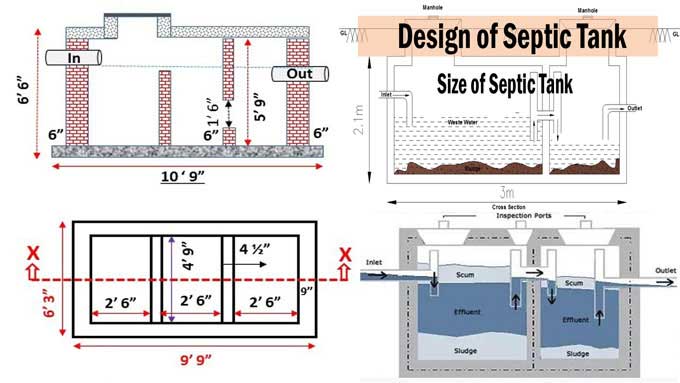
Designing a Septic Tank and Calculating its Size Effectively

Septic Tank is an underground chamber comprising RCC, plain concrete, fiberglass, plastic, or steel that serves as primary treatment facilities for waste material that decomposes into solids or semi-solids.
Workflow of Septic Tank
Inlet pipes deliver the liquid or solid effluent from the household to the septic tanks. It is called the detention period when the wastewater in the septic tank intends to store for at least 18 hours to 24 hours. Anaerobic bacteria decompose the sludge during this time, resulting in sludge. An outlet pipe directs the surface water to the soak pit. Therefore, it is necessary to remove the settled sludge after 1 or 2 years.
Define Soak Pit
Typically, a soak pit is a circular hole dug under natural ground. So, it is constructed with dry bricks or stone without mortar joints and is the perfect place for water to soak into the ground. There should be at least 900mm diameter and 1500mm depth. Moreover, it should keep at least 2 meters away from the groundwater.
Ventilation Pipes
Chemical reactions take place in the septic tanks. Chemical reactions produce toxic and nontoxic gases that can cause harm as well as bad odors. Anaerobic digestion of the collected sludge by bacteria and microorganisms produces gases such as hydrogen, sulfur, ammonia, methane, and carbon monoxide. As a result, it is necessary to remove these gases from the septic tank to reduce pressure damages.
Vent pipes must install on septic tanks. Otherwise, the odor will reach you. An attachment on the roof of the house connects the septic tank vent pipe to the house's vent pipe. Low pressure in the pipeline will allow the odor from the septic tank to escape to the roof.
Important Guidelines of Utilizing Septic Tank
Do?s
- You must construct the tank in the right place and of the right size.
- Reducing water usage will help prevent the tank from filling up too quickly and save water.
- Maintain a regular schedule for removing sludge.
- Maintain regular septic tank inspections.
- Don't disturb the flow of groundwater when building the septic tank.
- If there is a blockage in the septic tank, then act immediately to fix it.
- Manholes should facilitate easy access to tanks.
Don?t
- A tank with insufficient capacity could cause flushed wastewater to back up into our house, so tank capacity is very important.
- To avoid unnecessary blockages, do not flush garbage, sanitary items, paper, or other solid materials.
- Septic tanks should not be filled with water from other sources.
- To protect the environment, wastewater should not flow into the ground.
Proper Calculation of Septic Tank as Per User Consumption
The septic tank's capacity must design correctly because a small septic tank may result in wastewater backing up into the house or requiring frequent water cleaning while increasing maintenance costs.
A 5-person household's daily water consumption
For five people, this amounts to 5 liters per day for cooking and 85 liters per person for bathing & toileting. That means for 5 five people it is (85* 5 =425). 30 liters is for washing clothes and utensils. 10 liters is for the cleaning solution. The rest is the 5 liters.
So you can take 475 liters on average for 5 persons.
As a rule, we count three days as the period of detention. It should be able to hold the household wastewater for at least three days so that the septic tank can perform properly.
475 x 3 = 1425 liters of wastewater in 3 days
A home should have a minimum capacity of 2000 liters. As a result, septic tanks should have a minimum depth of 1.8m. Approximately 30 liters of sludge settle down per person per year. Here, we remove it every two years. A home with five members would require a tank of this size.
Structural Calculation
- So total sludge is 30 liters x 5 people x 2 years = 300 liters.
- The total capacity of the tank is 2300 Liters, 2000+300 = 2300L.
- It is well known that 1 cum = 1000 Liters = 2300/1000 = 2.3 cum.
- Septic tank area required at 1.8m depth = 2.3 / 1.8 = 1.2 sq. m.
- The ratio of length to width of a septic tank is 4:1 or 2:1.
- Assume 4:1 L:B ratio.
To learn more, watch the following video tutorial.
Video Source: CE&T - Civil Engg & Technology
- Therefore, 4B x B = 1.2 Square meter where B = 0.54 meter.
- A minimum width of 750mm is required in a tank, so L = 4 * 0.75 = 3 m.
- Dimensions: 3m in length, 0.75m in width, 1.8+0.3 = 2.1 meters in depth.
- A tank's capacity is 3 x 2.1 x 0.75 = 4.725 Cum = 4.725 x 1000 = 4725 Liters.


